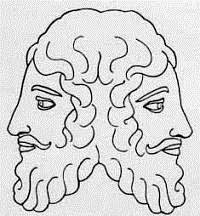What's Up, Doc? The Meaning Behind 'January'
By Randall Freeman, PhD On Jan. 1, we celebrate the New Year with resolutions, food, and football. Resolutions are broken (probably becaus...
http://www.menifee247.com/2015/01/whats-up--the-meaning-behind-january.html
By Randall Freeman, PhD
On Jan. 1, we celebrate the New Year with resolutions, food, and football. Resolutions are broken (probably because of overindulging in the second item) and we sit in our lounge chairs wondering what happened.
Jan. 1 is also a time to reflect on the year just passed. We remember fondly those people and events that enriched us. We look with regret and sadness on those events that were less than positive. We mourn those who passed.
In Roman mythology, Janus, for whom January is named, was the god (small ‘g’) of new beginnings and transitions, making him the perfect one to end one year and begin another. Janus is depicted as having two faces -- one face looking backward at the past and one looking forward to the future.
The word "janus" is from Latin, meaning "to go". Janus is thought by many to be unique to the Roman mythology. He represents gates, doors, doorways, passages, beginnings, and endings. The English word "janitor" finds its origins in the word "janus". This makes sense when one think of the gates and doorways leading to both the past and the future. We clean up the past and prepare for the future.
Janus represents change and transitions (i.e., the advancement of the past to the future and vice versa, from one form to another, from one vision to another, and young people's growth to adulthood.) He exemplified time, because he could see into the past with one face and into the future with the other.
Janus was venerated at the beginnings of the harvest and planting times, as well as at marriages, deaths and other beginnings. He signified the middle ground between barbarism and civilization, rural and urban space, youth and adulthood. Having jurisdiction over beginnings Janus had a fundamental association with premonitions and portents.
Some representations of Janus show him as in the drawing above. Others had one figure with a beard, the other without one. Many Roman coins appear with the faces of Janus inscribed upon them.
When contemplating the coming year of 2015, think of Janus and how he has influenced not only our calendar but many of our longstanding traditions as well.
Randall Freeman and his family have lived in Menifee since 1993. Randy teaches kindergarten in Perris and his wife Karen teaches first grade here in Menifee at Freedom Crest Elementary School. They are the parents of four daughters: Daniela, 17, and 13-year-old triplets Sarah, Holly, and Megan. Randy earned his PhD in early childhood education in 2011 and has served on the Menifee Union School Board since 2008. As he explains it, this makes him Karen's boss for the first and only time in the marriage. His column will appear here every other Tuesday.
On Jan. 1, we celebrate the New Year with resolutions, food, and football. Resolutions are broken (probably because of overindulging in the second item) and we sit in our lounge chairs wondering what happened.
Jan. 1 is also a time to reflect on the year just passed. We remember fondly those people and events that enriched us. We look with regret and sadness on those events that were less than positive. We mourn those who passed.
In Roman mythology, Janus, for whom January is named, was the god (small ‘g’) of new beginnings and transitions, making him the perfect one to end one year and begin another. Janus is depicted as having two faces -- one face looking backward at the past and one looking forward to the future.
The word "janus" is from Latin, meaning "to go". Janus is thought by many to be unique to the Roman mythology. He represents gates, doors, doorways, passages, beginnings, and endings. The English word "janitor" finds its origins in the word "janus". This makes sense when one think of the gates and doorways leading to both the past and the future. We clean up the past and prepare for the future.
Janus represents change and transitions (i.e., the advancement of the past to the future and vice versa, from one form to another, from one vision to another, and young people's growth to adulthood.) He exemplified time, because he could see into the past with one face and into the future with the other.
Janus was venerated at the beginnings of the harvest and planting times, as well as at marriages, deaths and other beginnings. He signified the middle ground between barbarism and civilization, rural and urban space, youth and adulthood. Having jurisdiction over beginnings Janus had a fundamental association with premonitions and portents.
Some representations of Janus show him as in the drawing above. Others had one figure with a beard, the other without one. Many Roman coins appear with the faces of Janus inscribed upon them.
When contemplating the coming year of 2015, think of Janus and how he has influenced not only our calendar but many of our longstanding traditions as well.
Randall Freeman and his family have lived in Menifee since 1993. Randy teaches kindergarten in Perris and his wife Karen teaches first grade here in Menifee at Freedom Crest Elementary School. They are the parents of four daughters: Daniela, 17, and 13-year-old triplets Sarah, Holly, and Megan. Randy earned his PhD in early childhood education in 2011 and has served on the Menifee Union School Board since 2008. As he explains it, this makes him Karen's boss for the first and only time in the marriage. His column will appear here every other Tuesday.







